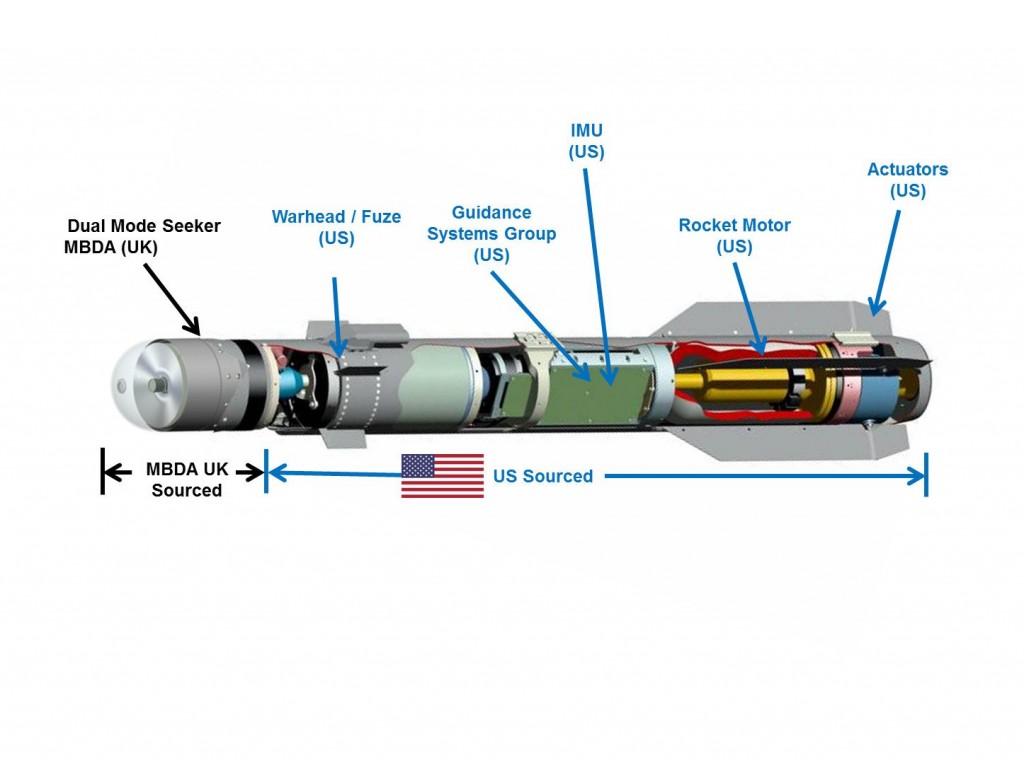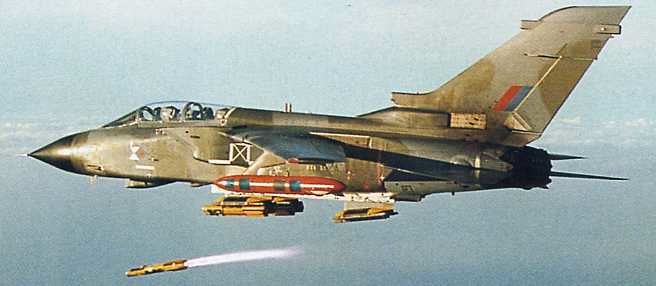Eye On Fewer Drone Civilian Deaths, MBDA Challenges Lockheed, Raytheon With Brimstone Missile
Posted on
AUSA: As concern increases that too many innocents are killed in drone strikes, a European missile company is telling Congress it has a highly accurate missile called the Brimstone 2 that can do the job with fewer casualties and minimal collateral damage.
“What we have found as a company is that this missile does not miss,” said Douglas Denneny, vice president for business development at MBDA Inc., the American subsidiary of the European missile defense company. The Brimstone missile, which uses a laser designator and a sophisticated radar to find its targets, has been fired 300 times in Afghanistan and Libya and has a 98 percent strike rate.
The British Ministry of Defense paid for a series of five missile tests at the Navy’s China Lake complex in California to demonstrate the missile, which is normally racked in groups of three on the British Typhoon fighters. The shots were taken at vehicles traveling at speeds of up to 70 mph. All five tests were successful, with all targets destroyed. CORRECTED: UK paid for tests.
The shots were taken from British Typhoons. The UK is integrating the Brimstone onto the drones with help from the US Air Force.
MBDA has briefed professional staff members of the House Permanent Select Committee on Intelligence (HPSCI) as well as other congressional committees on Brimstone 2’s capabilities. Senior Air Force and Navy leaders have also talked with MBDA about the missile, Denneny told me this morning. One of the major differences between the Hellfire, used for all CIA and Air Force Predator strikes, and Brimstone 2 is that the current missile explodes and generates a large and deadly field of fragments. The Brimstone warhead uses a shaped charge and destroys the target with a much contained explosion that generates relatively little debris.
Also, because it is much more accurate than the Hellfire, far fewer Brimstone missiles need be fired at a target. In addition to saving time and money, this is also likely to save lives since Hellfires often have to be fired in salvos to ensure the target is destroyed,
But replacing the Hellfire missiles used on drones to kill terrorists is just one small part of the market MBDA has targeted here. They want to sell Brimstone’s to fly on the Navy’s F-18s and Fire Scout drone, the Air Force’s F-16s and F-35s and the Army’s Apache helicopters.
Because of its small footprint and ability to track fast-moving and agile targets MBDA also hopes to convince the Navy that Brimstone would make a useful weapon for the Littoral Combat Ship (LCS) against fast boats, such as the ones Iran deploys in the Persian Gulf.
To help attract congressional support, MBDA pledges to build Brimstone 2s at a plant they own in Huntsville, Ala. inside the Redstone Arsenal. While company officials would not confirm that Sen. Richard Shelby of Alabama inserted the language, they did tell us that there is $4 million in the Senate Appropriations Committee markup to integrate the Brimstone 2 on the Navy’s F-18.
 Brimstone has two prime competitors for this market: Lockheed Martin and Raytheon, who are competing for the wobbly $5 billion program known as JAGM, for Joint Air To Ground Missile.
Brimstone has two prime competitors for this market: Lockheed Martin and Raytheon, who are competing for the wobbly $5 billion program known as JAGM, for Joint Air To Ground Missile.
Where Brimstone boasts a two-mode seeker, using a semi-active laser designator and an active milllimeter wave radar, to find and lock onto its target, Lockheed and Raytheon are pursuing a different approach.
The Raytheon JAGM features an uncooled tri-mode seeker with semiactive laser (SAL), uncooled imaging infrared and millimeter wave guidance. Lockheed’s system uses a cooled seeker that it claims provided much better resolution. Raytheon counters that its system is lighter, more reliable and cheaper.
J.R. Smith, head of business development for Raytheon’s JAGM, welcomed the competition from Brimstone.
“The fact that MBDA wants to enter this market is a good thing. It’s all about competition. This will begin to force folks to think hard about their price,” he said. On that basis, he thinks Raytheon is in a good place.
Smith told me MBDA is “quoting $160 to $170K for their missile….From our standpoint you need to do better than $160 to 170K for the missile.”
Here’s what Lockheed spokeswoman Melissa Hilliard said when we asked for comment: ;We will let the DoD identify companies it wishes to consider as potential contractors. We have our contract, and our focus is on delivering the low-cost and low-risk dual mode JAGM guidance section our customer has asked for.”
Let the games begin.
Subscribe to our newsletter
Promotions, new products and sales. Directly to your inbox.

